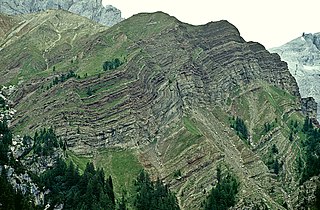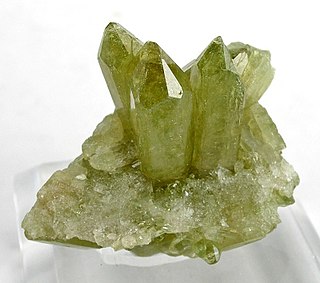 W
WThe Geology of Italy includes mountain ranges such as the Alps, the Dolomites and the Apennines formed from the uplift of igneous and primarily marine sedimentary rocks all formed since the Paleozoic. Some active volcanoes are located in Insular Italy.
 W
WThe Adriatic or Apulian Plate is a small tectonic plate carrying primarily continental crust that broke away from the African plate along a large transform fault in the Cretaceous period. The name Adriatic Plate is usually used when referring to the northern part of the plate. This part of the plate was deformed during the Alpine orogeny, when the Adriatic/Apulian Plate collided with the Eurasian plate.
 W
WThe Austroalpine nappes are a geological nappe stack in the European Alps. The Alps contain three such stacks, of which the Austroalpine nappes are structurally on top of the other two. The name Austroalpine means Southern Alpine, because these nappes crop out mainly in the Eastern Alps.
 W
WBassanite is a calcium sulfate mineral with formula CaSO4·1/2H2O or 2CaSO4·H2O. In other words it has half a water per CaSO4 unit hence its synonym calcium sulfate hemihydrate.
 W
WThe Rock 1 of Bedolina, the so-called Bedolina Map, is a famous engraved prehistoric rock which is part of the Camonica valley petroglyph complex. It is known as being one of the most ancient topographic maps, interpreted as the depiction of cultivated plots, mountain paths and villages. The locality of Bedolina pertains to the Capo di Ponte municipality (BS-I), near the hamlet of Pescarzo. The area is included in the Seradina-Bedolina Archaeologic park, lying on a prominent terrace on the right slope of the Camonica valley, at an altitude of 530 m above the sea level. The rock, a flat surface of Permian sandstone polished by the Pleistocene glacier, is 9 m long and 4 m wide.
 W
WThe Bletterbach is a stream in South Tyrol, Italy.
 W
WThe Engadine Line is an over 50 kilometres (30 mi) long strike-slip fault in the Swiss canton of Graubünden, which extends into Italy and Austria. It runs along the Engadine Valley and the Bregaglia Valley and offsets Austroalpine and Penninic units in a sinistral direction. The western end of the fault appears to peter out into ductile deformation in the Bregaglia Valley or continues as the Gruf Line to the southwest; the eastern end is buried by the Ötztal tectonic block and may continue as the "Inntal fault", "Isar fault" or "Loisach fault".
 W
WItaly is located in southern Europe and comprises the long, boot-shaped Italian Peninsula, the southern side of Alps, the large plain of the Po Valley and some islands including Sicily and Sardinia. Corsica, although belonging to the Italian geographical region, has been a part of France since 1769. Italy is part of the Northern Hemisphere. Two of the Pelagie islands are located in the African continent.
 W
WThe geology of Sicily records the collision of the Eurasian and the African plates during westward-dipping subduction of the African slab since late Oligocene. Major tectonic units are the Hyblean foreland, the Gela foredeep, the Apenninic-Maghrebian orogen, and the Calabrian Arc. The orogen represents a fold-thrust belt that folds Mesozoic carbonates, while a major volcanic unit is found in an eastern portion of the island. The collision of Africa and Eurasia is a retreating subduction system, such that the descending Africa is falling away from Eurasia, and Eurasia extends and fills the space as the African plate falls into the mantle, resulting in volcanic activity in Sicily and the formation of Tyrrhenian slab to the north.
 W
WThe Giudicarie Line is a major geologic fault zone in the Italian Alps, named for the Giudicarie valleys area. It runs from Meran in the northeast more or less straight along the lower part of the Val di Sole, along the Val Rendena and then along the Chiese valley to the Lago d'Idro.
 W
WThe Hohe Tauern window is a geological structure in the Austrian Central Eastern Alps. It is a window in the Austroalpine nappes where high-grade metamorphic rocks of the underlying Penninic nappes crop out. The structure is caused by a large dome-like antiform in the nappe stacks of the Alps.
 W
WThe 1980 Irpinia earthquake took place in Southern Italy on November 23 with a moment magnitude of 6.9 and a maximum Mercalli intensity of X (Extreme). The shock was centered on the village of Conza and left at least 2,483 people dead, at least 7,700 injured, and 250,000 homeless.
 W
WThe Ivrea zone is a tectonic terrane in the Italian Alps, that consists of a steeply dipping piece of the Earth’s lower crust of the Apulian plate. The zone is named after the Italian city of Ivrea.
 W
WThe Periadriatic Seam is a distinct geologic fault in Southern Europe, running S-shaped about 1000 km from the Tyrrhenian Sea through the whole Southern Alps as far as Hungary. It forms the division between the Adriatic plate and the European plate. The term Insubric line is sometimes used to address the whole Periadriatic Seam, but it is more commonly used to mean just a western part of it.
 W
WThe Sesia unit or Sesia nappe, also called the Sesia-Dent Blanche unit is a tectonic unit or terrane in the Swiss and Italian Alps. The zone crops out in the Pennine Alps and in the southeastern part of the Aosta Valley. It is widely seen as part of the Austroalpine nappes and correlated with the Dent Blanche nappe that crops out further to the northwest.
 W
WThe Southern Alps are a geological subdivision of Alps that are found south of the Periadriatic Seam, a major geological faultzone across the Alps. The southern Alps contain almost the same area as the Southern Limestone Alps. The rocks of the southern Alps gradually go over in the Dinarides or Dinaric Alps to the south-east. In the south-west they disappear below recent sediments of the Po basin that are lying discordant on top of them.
 W
WVesuvianite, also known as idocrase, is a green, brown, yellow, or blue silicate mineral. Vesuvianite occurs as tetragonal crystals in skarn deposits and limestones that have been subjected to contact metamorphism. It was first discovered within included blocks or adjacent to lavas on Mount Vesuvius, hence its name. Attractive-looking crystals are sometimes cut as gemstones. Localities which have yielded fine crystallized specimens include Mount Vesuvius and the Ala Valley near Turin, Piedmont.